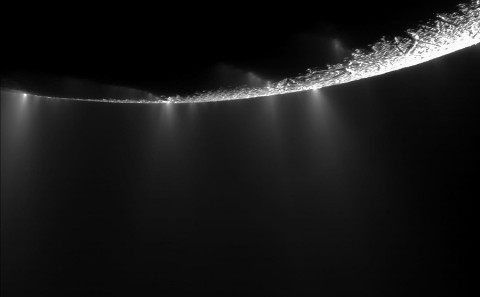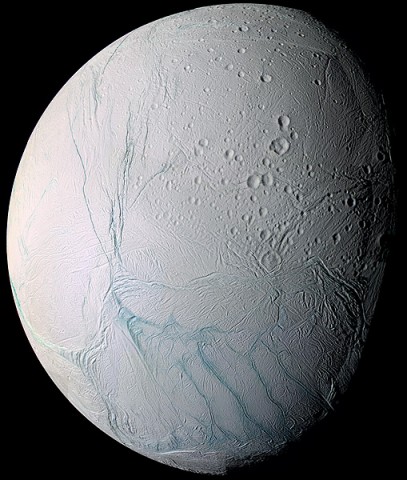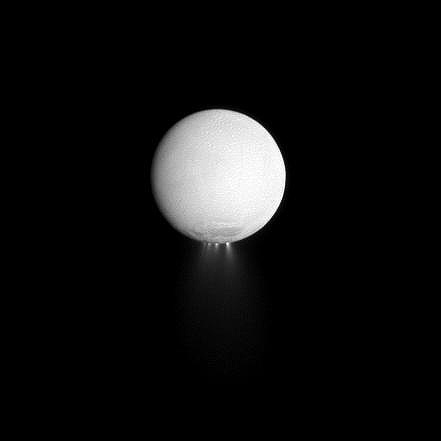Is it Snowing Microbes on Enceladus?
Written by Dauna Coulter
Science at NASA
 Washington, D.C. – There’s a tiny moon orbiting beyond Saturn’s rings that’s full of promise, and maybe — just maybe — microbes.
Washington, D.C. – There’s a tiny moon orbiting beyond Saturn’s rings that’s full of promise, and maybe — just maybe — microbes.
In a series of tantalizingly close flybys to the moon, named “Enceladus,” NASA’s Cassini spacecraft has revealed watery jets erupting from what may be a vast underground sea. These jets, which spew through cracks in the moon’s icy shell, could lead back to a habitable zone that is uniquely accessible in all the solar system.

Thermal measurements of Enceladus’s fissures have revealed temperatures as high as -120 deg Fahrenheit (190 Kelvin). “If you add up all the heat, 16 gigawatts of thermal energy are coming out of those cracks,” says Porco.

She believes the small moon, with its sub-surface liquid sea, organics, and an energy source, may host the same type of life we find in similar environments on Earth.
“The kind of ecologies Enceladus might harbor could be like those deep within our own planet. Abundant heat and liquid water are found in Earth’s subterranean volcanic rocks. Organisms in those rocks thrive on hydrogen (produced by reactions between liquid water and hot rocks) and available carbon dioxide and make methane, which gets recycled back into hydrogen. And it’s all done entirely in the absence of sunlight or anything produced by sunlight.”
But what makes Enceladus special is that its habitable zone offers itself up for easy access.
“It’s erupting out into space where we can sample it. It sounds crazy but it could be snowing microbes on the surface of this little world. In the end, it’s is the most promising place I know of for an astrobiology search. We don’t even need to go scratching around on the surface. We can fly through the plume and sample it. Or we can land on the surface, look up and stick our tongues out. And voilà…we have what we came for.”
The source of Enceladus’s heat appears to be Saturn itself. Researchers say Saturn’s gravitational pull causes the moon’s shape to change slightly on a daily basis as it orbits. Flexing motions in its interior generate heat–like the heat you feel in a paperclip when you bend it back and forth rapidly.“But the tidal flexing occurring now is not enough to account for all the heat presently coming out of Enceladus. One way out of this dilemma is to assume that some of the heat observed today was been generated and stored internally in the past.”

Porco believes Enceladus’s orbit could have been much more eccentric, and the greater the eccentricity, she says, the greater the tidal flexing and resulting structural variations that produce the heat. In this scenario, the heat would have been stored inside the little moon by melting some of the ice to recharge the liquid sea.
“Now that the orbit’s eccentricity has lessened, the heat emanating from the interior is a combination of heat produced today and in the past. But since more heat is coming out presently than is being produced, Enceladus is in a cooling off stage and the liquid water is returning to ice. There are models to show that it never really freezes entirely, so the eccentricity may increase again, restarting the cycle.”
Whatever is turning up the heat, Porco has a plan of action. It’s simple:
“We need to get back to Enceladus and check it out.”



Shouldn’t you be able to detect life/organic molecules from a distance? Just bounce a laser beam (I don’t know which frequencies would do best) and do spectrographic analysis when it comes back.
Cool article in any case! :-)